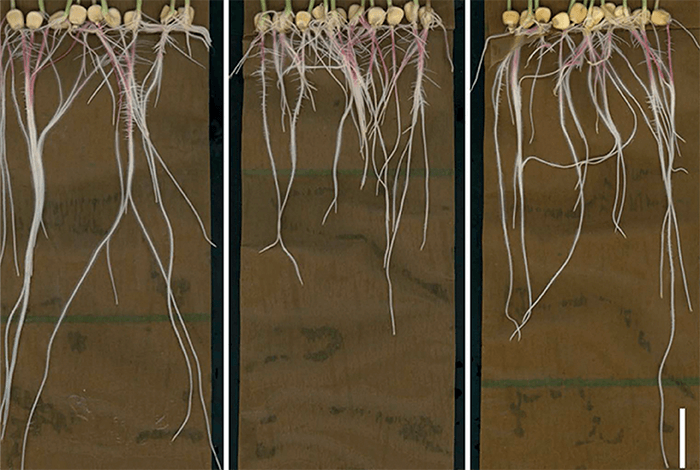Solving the maize
Researchers from Stanford University and University of California San Diego have developed a new understanding of essential root chemicals that are responsible for plant growth. The team, which included Richard Zare – a Power List regular going back to the inaugural 2013 List – used DESI-MSI to profile where key small molecules are distributed along stem cells of maize plant roots and how their placement factors into the plant’s maturation. “Having more information about how roots grow could be useful in conservation as we think about protecting our plants in natural environments and making them more sustainable, especially in agriculture,” said co-author Alexandra Dickinson.

MSI: from plants to ants…
Another highlight for imaging enthusiasts: researchers have used a combination of high-resolution MSI and micro-computed tomography to map the three-dimensional distribution of neuropeptides in the brains of two ant species. “These findings have the potential to fundamentally alter the way we study complex neurobiological processes,” said co-lead author Benedikt Geier. “Our method opens up new perspectives when it comes to observing the brains of social insects more closely and better understanding the functioning of nervous systems where chemistry and anatomy are fully attuned.”
A beginner’s guide to mass spec proteomics
How does mass spectrometry proteomics work? How do I perform a proteomic experiment? Where can I learn more? If you’re a beginner to the field and these are the questions you dare not ask, Steven R. Shuken, postdoctoral research fellow in the Department of Cell Biology at Harvard Medical School, has you covered. Shuken’s tutorial – which is free to access for the next six months – is intended to be an accessible illustrated guide to the technical details of a relatively simple quantitative proteomic experiment.
An AI approach to polymer sequencing
The National Institute for Materials Science (NIMS) in Japan has developed an AI-based mass spectrometric technique that can determine the monomeric sequence of a polymer. Despite the random fragmentation of copolymers, this technique identifies and quantifies the unique patterns associated with the length and number of monomer components. With this discovery, scientists have a better understanding of copolymers and can develop innovative polymer materials through sequence engineering.
Robinson’s membrane mastery
Carol Robinson was awarded the John B. Fenn Award at ASMS for her contributions to the mass spec field. Over the past three decades, Robinson has transformed our understanding of the structures and interactions of complex biological molecules, including membrane proteins – which continues. Last week, Robinson and colleagues published a paper on the characterization of membrane protein complexes using top-down MS. The team were able to overcome the energy limits with top-down MS using a modified Orbitrap Eclipse Tribrid mass spectrometer coupled to an infrared laser within a high-pressure linear ion trap.
Thermo Fisher Scientific made a splash with their Orbitrap Astral Mass Spectrometer. Alexander Makarov gave a presentation about the new system, as did Jenny Van Eyk, who has been testing it out over the past few months. The Astral boasts two times deeper proteome coverage and up to four times more throughput compared with current mass spectrometers, according to the analytical giant.
Bruker announced two new launches at ASMS: the EVOQ DART-TQ+ system for chromatography-free triple-quadrupole mass spectrometry and the timsTOF Ultra mass spectrometer. The EVOQ DART-TQ+ is designed for point-of-need routine analysis, while the timsTOF Ultra aims to advance quantitative spatial and single-cell 4D-proteomics and 4D-lipidomics.
SCIEX’s Intabio ZT system is a fully-integrated microfluidic chip-based platform combining imaged capillary isoelectric focusing (icIEF) separation and UV detection. According to SCIEX, when coupled with the ZenoTOF 7600 system, the Intabio ZT eliminates the guesswork from early drug development stages and accelerates drug candidate selection.
Agilent introduced a pair of new instruments at this year's show. The Agilent 6495 Triple Quadrupole LC/MS System is designed for demanding targeted analysis applications. The Agilent Revident Quadrupole Time-of-Flight LC/MS (LC/QTOF) System offers uses new instrument architecture and is targeted toward food safety and environmental analysis. Agilent also launched two new software packages: Agilent AI Peak Integration for MassHunter Software and Agilent MassHunterBioConfirm 12.1.
Biognosys launched Spectronaut 18, the latest in the Spectronaut series – commercial software packages aimed at analyzing data-independent acquisition (DIA) proteomics experiments.
Waters announced a new desorption electrospray ionization (DESI) source for the Xevo TQ Absolute tandem quadrupole mass spectrometer. The aim is to enable faster and more sensitive targeted pre-clinical MS imaging experiments. Waters also announced updates to its SELECT SERIES MRT System, which – thanks to a new resolution enhancement mode – is capable of 300,000 FWHM resolution.
Credit: UC San Diego




